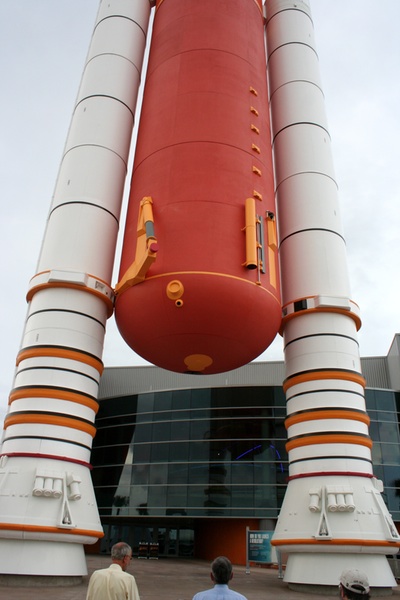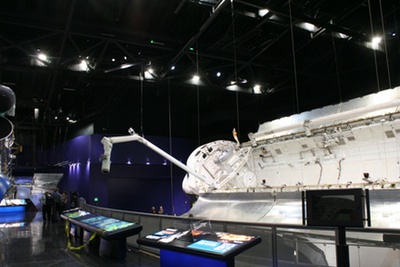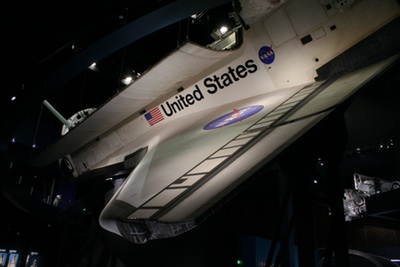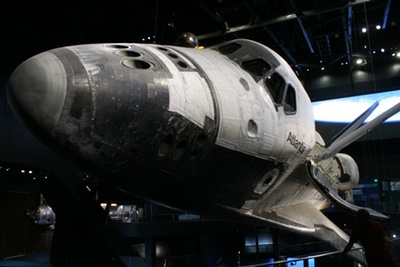Bird on a wireby Dwayne Day
|
 Visitors walk underneath a replica external tank and SRBs to enter the exhibit. (credit: D. Day) |
When the shuttle program was finally scheduled for an end, NASA sought proposals for museums to display the three remaining shuttles as well as the Enterprise test vehicle. The Smithsonian’s National Air and Space Museum pretty much by default received the orbiter the museum wanted, Discovery, but the other locations had to compete for the other ones. Naturally, the final selections created some controversy, although a NASA Inspector General report found that the process of selecting the locations was not influenced by politics. After looking at the plans for the locations, it is hard to argue that NASA made the wrong choices.
That is certainly true for the KSC Visitor Complex. There, Atlantis is displayed in a bold way, suspended in mid-air, its payload bay doors open and its robotic arm extended. It is a dramatic sight. Visitors can view Atlantis from virtually all angles, front, side, behind, and below.
 The open payload bay of Atlantis, with a Canadarm robotic arm extended. (credit: D. Day) |
Although the building was not yet complete when I visited, it was still possible to get a sense of the overall visitor’s experience. Visitors will approach the building by walking underneath a shuttle External Tank and between two Solid Rocket Boosters. They then ascend a ramp inside the building and go into an eighteen-minute movie about the Space Shuttle program and Atlantis. Upon leaving the movie, they are first confronted with a full scale mockup of the Hubble Space Telescope, the most famous shuttle payload ever, and the front of Atlantis, looking slightly weathered from its multiple flights into space.
Visitors can then walk along the side of the orbiter, almost within reach of the payload bay door, or go up onto a slightly raised viewing platform. The platform has interactive displays about the shuttle program that show a timeline of shuttle flights that can be consulted for more information on specific missions. The upper platform also has a cutaway mockup of the Atlantis flight deck that was still incomplete and taped off during my visit.
 Atlantis seen from below. (credit: D. Day) |
After viewing Atlantis and the Hubble mockup, visitors can walk past a subscale model of a portion of the International Space Station and then down a ramp, past a dramatic image of a reentering orbiter, emerging underneath Atlantis’ heat shield. The lower level features a number of exhibits—none of them yet complete during my visit—covering such issues as shuttle launch and landing, the space station, and training and simulation. Not all of the exhibits are mockups; on display is the actual “beanie cap” from pad 39B that was used for venting oxygen away from the shuttle’s external tank. Many visitors will want to head for the Shuttle Launch Experience, a dramatic simulation of a shuttle launch narrated by former astronaut Charlie Bolden that opened in May 2007. There’s also a gift shop filled with t-shirts, mugs, toys, books, DVDs, and other Atlantis-related merchandise.
Until it is complete, it will not be possible to accurately judge the overall quality of the new Atlantis exhibit. But at first glance it appears to be every bit as outstanding as the Apollo/Saturn V Center.
